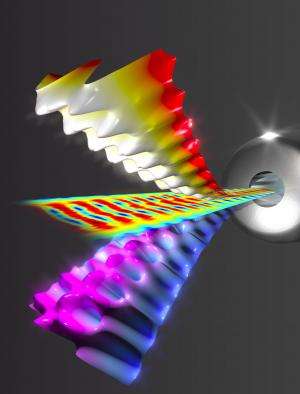Researchers peek at the forgotten component of light

(Phys.org) —Physicists from FOM institute AMOLF have for the first time simultaneously measured the electrical and magnetic fields of light. With such a measurement scientists can better understand the behaviour of light in nanostructured metamaterials – for example the material from which invisibility cloaks can be made. The AMOLF researchers published their findings on 15 December 2013 in Nature Photonics.
Light consists of both electrical and magnetic fields that vibrate with a frequency of 300 trillion times per second. Over the past twenty years, measurements of the local electrical field of light have considerably advanced our understanding of the behaviour of light in and around nanomaterials. Recently, however, materials with a negative refractive index have been developed, which make fascinating effects possible: for example these can be used for an invisibility cloak or for lenses with ultra-high resolutions. These effects emerge from the interaction between the material and both the electrical and magnetic fields of light. Consequently researchers can no longer neglect the magnetic component.
Two fields with one stone
To measure both fields simultaneously, the AMOLF researchers took an extremely small needle containing an optical fibre just 200 nanometres (200 billionths of a metre) wide. The fibre was coated with a thin layer of aluminium. The optical fibre conducted a small part of the light under the needle to a detector. By moving the needle in a plane above an object, the device forms an image of the distribution of the light just above the object.
For a long time it had been assumed that such a needle only observed the electrical field. Recently, however, a controversy arose about this when various scientists suggested that the needle did not register the electrical field but the magnetic field. To resolve this dispute the AMOLF team measured the light distribution above a photonic crystal.
Such a crystal traps light in a silicon wafer just 220 nanometres thick, in which a smart pattern of holes has been etched. The photonic crystals have the unusual characteristic that the electrical and magnetic fields respond differently when the distance to the crystal is changed. By scanning at different distances to the crystal the researchers could unravel the contributions of the electrical and magnetic fields above the crystal.
The measurements open up new possibilities for studying the interaction between light and matter at the nanoscale. Consequently, the researchers expect that their discovery will provide a considerable boost to the development of new meta-materials.
More information: Simultaneous measurement of nanoscale electric and magnetic optical fields, B. le Feber, N. Rotenberg D. M. Beggs and L. Kuipers, Nature Photonics, 15 December 2013. DOI: 10.1038/nphoton.2013.323
Journal information: Nature Photonics



















